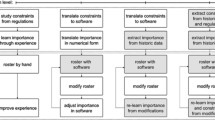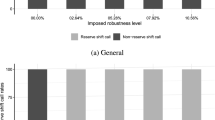Abstract
The production of effective workforce rosters is a common management problem. Rostering problems are highly constrained and require extensive experience to solve manually. The decisions made by expert rosterers are often subjective and are difficult to represent systematically. This paper presents a formal description of a new technique for capturing rostering experience using case-based reasoning methodology. Examples of previously encountered constraint violations and their corresponding repairs are used to solve new rostering problems. We apply the technique to real-world data from a UK hospital.
Access this chapter
Tax calculation will be finalised at checkout
Purchases are for personal use only
Preview
Unable to display preview. Download preview PDF.
Similar content being viewed by others
References
Abdennadher, S., Schlenker, H.: INTERDIP – an Interactive Constraint Based Nurse Scheduler. In: Proc. 1st Int. Conf. Exhib. Pract. Applic. Constraint Technol. Logic Program, PACLP (1999)
Arthur, J.L., Ravindran, A.: A Multiple Objective Nurse Scheduling Model. AIIE Trans. 13, 55–60 (1981)
Bailey, J., Field, J.: Personnel Scheduling with Flexshift Models. J. Oper. Manage. 5, 327–338 (1985)
Beaumont, N.: Scheduling Staff Using Mixed Integer Programming. Eur. J. Oper. Res. 98, 473–484 (1997)
Berrada, I., Ferland, J.A., Michelon, P.: A Multi-objective Approach to Nurse Scheduling with Both Hard and Soft Constraints. Socio-Econ. Planning Sci. 30, 183–193 (1996)
Burke, E.K., De Causmaecker, P., Vanden Berghe, G.: A hybrid tabu search algorithm for the nurse rostering problem. In: McKay, B., Yao, X., Newton, C.S., Kim, J.-H., Furuhashi, T. (eds.) SEAL 1998. LNCS (LNAI), vol. 1585, pp. 187–194. Springer, Heidelberg (1999)
Burke, E.K., Cowling, P.I., De Causmaecker, P., Vanden Berghe, G.: A Memetic Approach to the Nurse Rostering Problem. In: Applied Intelligence, pp. 199–214. Kluwer, Dordrecht (2001)
Cheng, B.M.W., Lee, J.H.M., Wu, J.C.K.: A Constraint-Based Nurse Rostering System Using a Redundant Modeling Approach. Department of Computer Science and Engineering, The Chinese University of Hong Kong (1996)
Dowsland, K.A., Thompson, J.M.: Solving a Nurse Scheduling Problem with Knapsacks, Networks and Tabu Search. J. Oper. Res. Soc. 51, 825–833 (2000)
Dowsland, K.: Nurse Scheduling with Tabu Search and Strategic Oscillation. Eur. J. Oper. Res. 106, 393–407 (1998)
Kolodner, J.L.: Case-Based Reasoning. Morgan Kaufmann, San Mateo (1993)
Meisels, A., Gudes, E., Solotorevski, G.: Employee Timetabling, Constraint Networks and Knowledge-Based Rules: A Mixed Approach. In: Burke, E.K., Ross, P. (eds.) PATAT 1995. LNCS, vol. 1153, pp. 93–105. Springer, Heidelberg (1996)
Meyer auf’m Hofe, H.: Solving Rostering Tasks as Constraint Optimization. In: Burke, E., Erben, W. (eds.) PATAT 2000. LNCS, vol. 2079, pp. 280–297. Springer, Heidelberg (2001)
Miller, M.L., Pierskalla, W., Rath, G.: Nurse Scheduling Using Mathematical Programming. Oper. Res. 24, 857–870 (1976)
Miyashita, K., Sycaras, K., Mizoguchi, R.: Capturing Scheduling Knowledge from Repair Experiences. Int. J. Human-Comput. Stud. 41, 751–773 (1994)
Scott, S., Simpson, R.: Case-bases Incorporating Scheduling Constraint Dimensions – Experiences in Nurse Rostering. In: Smyth, B., Cunningham, P. (eds.) EWCBR 1998. LNCS (LNAI), vol. 1488, pp. 392–401. Springer, Heidelberg (1998)
Silvestro, R., Silvestro, C.: An Evaluation of Nurse Rostering Practices in the National Health Service. J. Adv. Nursing 32, 525–535 (2000)
Warner, M.: Scheduling Nursing Personnel According to Nurse Preference: a Mathematical Programming Approach. Oper. Res. 24, 842–856 (1976)
Author information
Authors and Affiliations
Editor information
Editors and Affiliations
Rights and permissions
Copyright information
© 2003 Springer-Verlag Berlin Heidelberg
About this paper
Cite this paper
Petrovic, S., Beddoe, G., Vanden Berghe, G. (2003). Storing and Adapting Repair Experiences in Employee Rostering. In: Burke, E., De Causmaecker, P. (eds) Practice and Theory of Automated Timetabling IV. PATAT 2002. Lecture Notes in Computer Science, vol 2740. Springer, Berlin, Heidelberg. https://doi.org/10.1007/978-3-540-45157-0_10
Download citation
DOI: https://doi.org/10.1007/978-3-540-45157-0_10
Publisher Name: Springer, Berlin, Heidelberg
Print ISBN: 978-3-540-40699-0
Online ISBN: 978-3-540-45157-0
eBook Packages: Springer Book Archive




